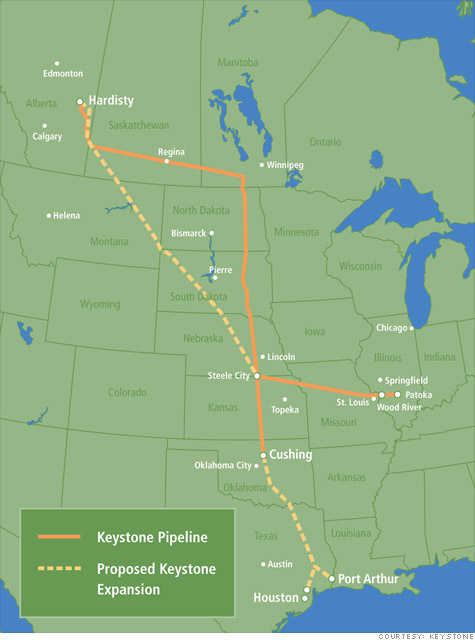
NEW YORK (CNNMoney) -- The heated discussion over whether to build a 1,700-mile oil pipeline from the oil sands region of Alberta, Canada, to the Gulf of Mexico is almost over.
Now, as a week of public comment meetings along the proposed route concludes, the U.S. State Department is expected to decide if the Keystone XL project is in the national interest and should go forward.
The decision rests with the State Department since the pipeline would cross America's borders. A decision is expected sometime before the end of the year.
The pipeline would pass through Montana, South Dakota, Nebraska, Kansas, Oklahoma and Texas. It has received support from the governors of all the states along the route, except Nebraska, where it would pass over a critical water source.
"I want to emphasize that I am not opposed to pipelines. I am opposed to the proposed Keystone XL Pipeline route because it is directly over the Ogallala Aquifer," Nebraska Gov. Dave Heineman said.
In a letter to President Obama, Heineman asked that the pipeline be rerouted because it could have detrimental effects on the aquifer, which provides water to farmers and ranchers.
Should the State Department approve the pipeline, the $7 billion project would be built by TransCanada (TRP), a large Canadian energy infrastructure company.
The State Department released its final version of the Environmental Impact Statement for the proposed project on Aug. 26 and concluded that the pipeline wouldn't pose a major threat to the resources along its route.
"TransCanada is pleased that the final environmental impact statement reaffirmed the environmental integrity of the project," the company said in a statement.
However, the pipeline is still meeting a lot of opposition from environmentalists who say that Canada's oil sands require more energy and water than conventional oil production and creates more greenhouse gases than regular oil.
"It is so thick that it has to be diluted with natural gas liquids to flow in a pipeline," said Ryan Salmon, the energy policy adviser at the National Wildlife Federation. "This mixture is more corrosive and abrasive than conventional oil, increasing the likelihood of pipeline spills."
"Producing this asphalt-like form of oil, called bitumen, destroys vast swaths of pristine forest, creates lakes of toxic wastewater while contaminating downstream freshwater, and emits three times more carbon pollution than conventional oil," Salmon added.
The oil sands in Canada are the United States' largest single source of foreign oil, contributing over 1 million barrels a day. Supporters say the pipeline is a surefire way to strengthen U.S. energy security in addition to creating much needed jobs.
TransCanada says building the pipeline would put 20,000 Americans directly to work during the construction phase and add an expected 118,000 spin-off jobs. The project would also, the company says, pump $20 billion into the U.S. economy and increase personal income by $6.5 billion.
But a report released this week by the Cornell University Global Labor Institute questions TransCanada's job creation claims.
"The project will create no more than 2,500-4,650 temporary direct construction jobs for two years, according to TransCanada's own data supplied to the State Department," according to the report.
The Cornell study also says there is strong evidence to suggest that a large portion of the steel pipe will not be produced in the United States.
TransCanada refuted the study.
"In regards to the Cornell document, it has multiple erroneous and misleading statements that ultimately lead to incorrect conclusions," said Terry Cunha, TransCanada's spokesman.
The State Department will hold an additional public comment meeting in Washington, D.C., at the end of next week. ![]()
| Overnight Avg Rate | Latest | Change | Last Week |
|---|---|---|---|
| 30 yr fixed | 3.80% | 3.88% | |
| 15 yr fixed | 3.20% | 3.23% | |
| 5/1 ARM | 3.84% | 3.88% | |
| 30 yr refi | 3.82% | 3.93% | |
| 15 yr refi | 3.20% | 3.23% |
Today's featured rates:
| Latest Report | Next Update |
|---|---|
| Home prices | Aug 28 |
| Consumer confidence | Aug 28 |
| GDP | Aug 29 |
| Manufacturing (ISM) | Sept 4 |
| Jobs | Sept 7 |
| Inflation (CPI) | Sept 14 |
| Retail sales | Sept 14 |